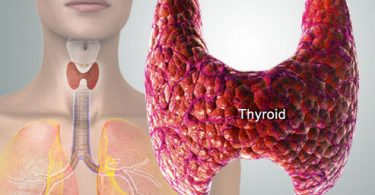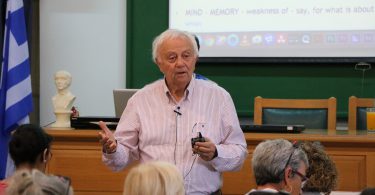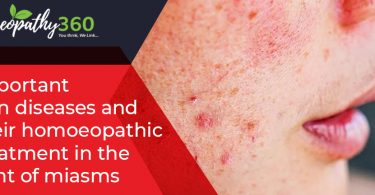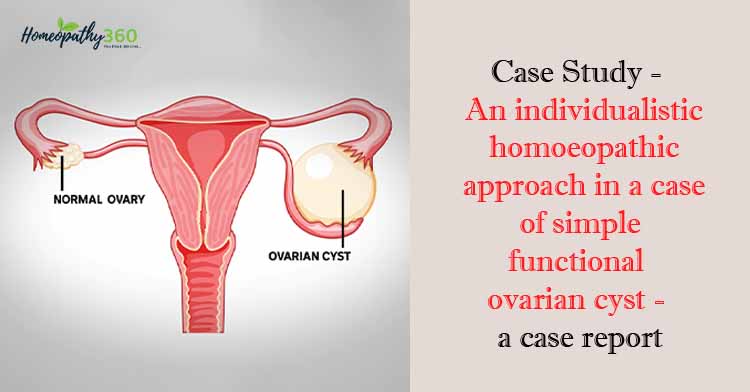
Abstract– Ovarian cysts are the most common benign intra abdominal mass, diagnosed during reproductive age, however simple cyst are likely to occur in all age groups. This is a case report of a 22 years old female patient complaining of dysmenorrhoea with dull aching abdominal pain since 5 months. Trans-abdominal USG of whole abdomen shows bulky left ovary (5.8cm×4.8cm) with left ovarian cyst (3.4cm×4.6cm). After she was treated with individualised homoeopathic medicine for over 15 months, trans-abdominal USG of whole abdomen reflected complete resolution of ovarian cyst along with normal ovary size (2.0cm×1.7cm). Possible causal attribution of changes was assessed by Modified Naranjo criteria (score 10 out of 13). Thus demonstrating a positive role of individualised homoeopathic treatment in a case of simple functional ovarian cyst.
Keywords- Simple functional ovarian cyst, ovarian cyst, dysmenorrhoea, Pulsatilla nigricsns.
Abbreviations: USG – ultrasonography, OPD – outpatient department, BMI – body mass index, OCPs – oral contraceptive pills, 1D – 1 dose
Introduction- Simple functional ovarian cyst is a fluid filled sac, formed within ovary, usually discovered incidentally, during a physical examination or imaging. It may contain solid, semi-solid or liquid materials. Mixed cystic and completely solid ovarian lesion have a higher rate of malignancy than simple cyst.[1] Simple functional cysts generally arises due to hormonal imbalance, resulting from faulty diet and regimen. They are painless, but depending on the size and nature of cyst, it may become painful, usually manifests with dull aching pain in lower abdomen; swelling of abdomen; heaviness in lower abdomen; dysmennorhoea along with no menstrual disorder; dysparunia; nausea, vomiting; breast tenderness.[1] These cyst are benign, having very low malignant potential[1-4]. Simple functional ovarian cysts maybe found in any age from menarche to menopause. The actual prevalance of ovarian cysts is unknown, as many patients remains undiagnosed and asymptomatic.[1] Risk factors for ovarian cyst formation includes infertility treatment, tamoxifen therapy, pregnacy, hypothyroidism, cigarette smoking, tubal ligation.[1] Large ovarian cyst (>3cm) may have complications like torsion of cyst, haemorrhage, rupture of the cyst, retention of urine, which requires prompt surgical management.[1] Hormonal therapy including the use of OCPs are not helpful in their resolution.[5]
Patient information: Mrs. RB., aged 22 years, obese, fair complexioned, BMI-32.5 kg/m2, self-employed, from a middle-class family, visited outpatient department (OPD) of a Govt. Homoeopathic medical college of West Bengal on 11/12/2020 complaining of continuous dull aching pain in whole abdomen, that appeared gradually. She was having this complaint for the past five months, she also cpmplained of having dysmenorrhoea. She had regular, profuse and protracted menstrual cycle, with duration of nine days. She was nulliparous, having no family history of malignancy. Trans-abdominal USG of whole abdomen on 28/12/2020 revealed simple ovarian cyst measuring (3.4cm×4.6cm) without any septation and internal echoes, with bulky left ovary, measuring (5.8cm×4.8cm); size of liver was enlarged(14.8cm) [Figure 1]. She was unwilling to take allopathic treatment, eventually opted for homoeopathic treatment.
Homoeopathic generalities: She was anxious, irritable but desires company, capricious, avaricious, had forsaken feeling, hot patient, having profuse thirst. She had white coated moist tongue, desire for spicy and sour food, meat, cold food; aversion no-such; normal bladder habit; hard and offensive stool, difficult to pass; heaviness in lower abdomen. She had no significant past and personal history.
Life Space investigation– After completing her graduation, she got married. Recently, she got a job. She lives with her husband and his family and has a happy married life.
After detailed case taking, analysis and evaluation of symptoms, following symptoms were considered for repertorisation [Table 1]:
Table 1: Analysis and evaluation of symptoms with miasmatic analysis
| Analysis and evaluation of symptoms | Symptoms | Miasmatic analysis |
| Characteristic mental generals | IrritabilityDesires companyCapriciousAvariceForsaken feeling | Sycotic PsoraPsoraPsoraPsycotic |
| Characteristic physical generals | Thirst- profuse Tongue- coated white, moist Desire for sour food, Desire for cold food, Desire for meat T/R- Hot Stool- constipated hard | PsoraPsoraPsoraSyphilitic PsoraSyphiliticPsora |
| Characteristic particular symptoms. | Aching dull pain in whole abdomen. dysmenorrhoea. Menses profuse and protracted. | Psora Psora SycoticPseudo-Psora |
This case was repertorised by Hompath Classic M.D. Version 8 software [Figure – 1] using J.T Kent’s Repertory- Repertory of the Homoeopathic Materia Medica [7]
Figure: 1- Repertorisation sheet
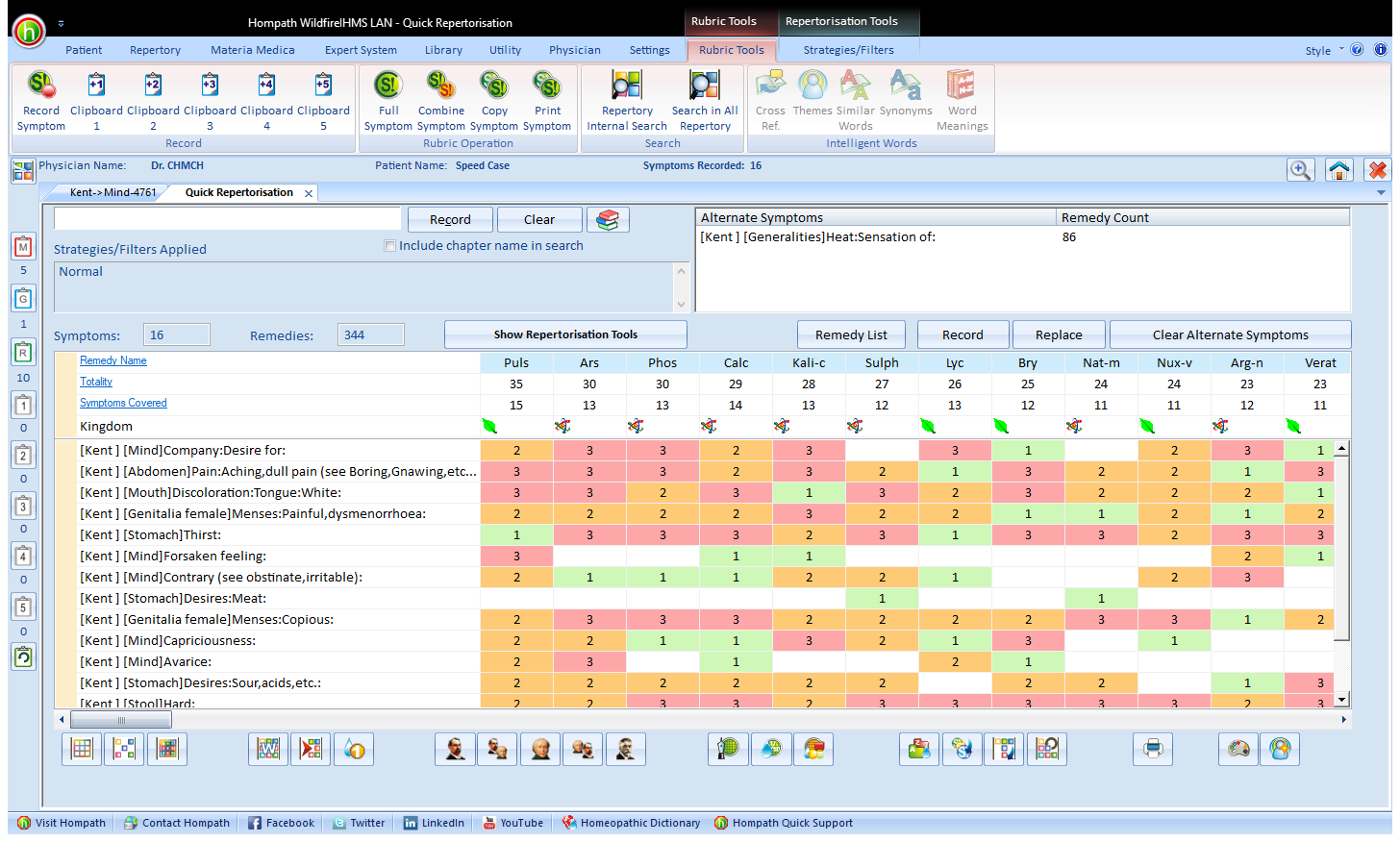
After repertorisation, Pulsatilla nigricans scored the highest marks 35/15, followed by Arsenicum album and Phosphorus scored 30/13, Calcarea carbonicum scored 29/14; but considering the analysis and evaluation of symptoms of the case, and consulting the materia medica8, Pulsatilla nigricans was selected [Figure-1]. Patient was followed up monthly or earlier as per need, details of diagnostic assessment, management are given in Table 2. On 18/05/2021 during a subsequent follow up, Pulsatilla nigricans 1M, 1 dose was given. Potency selection and repitition of dose was done as per homoeopathic philosophy.9,10
| Table 2: Details of follow-ups and prescription | ||
| Date | Symptoms | Prescription |
| 11/12/2020 | Dysmenorrhoea with continuous dull aching pain in whole abdomen, patient had regular, profuse and protracted menstrual cycle. USG of whole abdominal – ovarian cyst measuring (3.4cm×4.6cm) without any septation and internal echoes, with bulky left ovary, measuring (5.8cm×4.8cm) [Figure -2] | Pulsatilla nigricans 200/1D stat. Placebo for 3 weeks. |
| 11/01/2021 | No changes in any of symptoms. | Placebo for 4 weeks. |
| 08/02/2021 | Intensity of pain in abdomen reduced. Stool constipated, hard. Appetite poor, weakness, fatigue. Dysmenorrhoea was slightly reduced. Menses was regular, profuse and protracted. | Placebo for 6 weeks. |
| 28/4/2021 | Dysmenorrhoea mainly aggravated at night, with profuse protracted menses, dull aching pain in whole abdomen. Bowel habit was normal. | Placebo for 3 weeks. |
| 18/5/2021 | Dysmenorrhoea and dull aching pain in abdomen was same as before. Menses was profuse and protracted as before. Desire for cold food. Profuse thirst. Constipated hard stool. | Pulsatilla nigricans 1M/1D stat. Placebo for 3 weeks. Potency was changed as the patient was in a stand still condition. |
| 24/6/2021 | General condition of patient was slightly better. Appetite increased. Slight pain and uneasiness, heaviness of abdomen. Bowel habit was normal. Menses was profuse but not protracted, cycle duration 5 days. | Placebo for 3 weeks. |
| 19/7/2021 | General condition of patient was better than last visit. Dysmenorrhoea was less than last cycle. Bowel habit was normal. | Placebo for 6 weeks. |
| 5/10/2021 | Patient gradually improves. No pain in abdomen. Very slight dysmenorrhoea, profuse menses but 5 days duration of menstrual cycle. | Placebo for 8 weeks. |
| 12/12/2021 | Patient gradually improves. No pain in abdomen. no dysmenorrhoea, duration of menstrual cycle- 5 days. | Placebo for 6 weeks. |
| 11/3/2022 | General condition of patient was better. No further recurrence of symptoms. USG (on 3/03/2022) of whole abdomen report [Figure-3] was within normal limit. Complete resolution of left ovarian cyst, size of left ovary was within normal range (2.0cm×1.7cm). size of liver reduced in normal limit(12.3cm). | No medicine given. |
| Table 3: Assessment by Modified Naranjo criteria score | |||
| Item | Yes | no | not sure |
| Was there an improvement in the main complaint for which homoeopathic medicine was prescribed? | +2 | ||
| Did clinical improvement occur within a plausible time frame relative to drug intake? | +1 | ||
| Was there an initial aggravation of symptom? | 0 | ||
| Did the effect encompass more than main complaint i.e. were other symptoms ultimately improved or changed? | +1 | ||
| Did overall wellbeing improved? | +1 | ||
| Direction of cure: did some symptoms improve in the opposite order of development of disease? | +1 | ||
| Did at least two of following aspects apply to the order of improvement of symptoms | 0 | ||
| -from more important organ to less important organ | |||
| -from deeper to more superficial aspect of individual | |||
| -from above downwards | |||
| Did old symptoms ( defined as nonseasonal and non-cyclical that were previously thought to have resolve) reappear temporarily during course of improvement? | 0 | ||
| Are there alternate causes (other than medicine) that with a high probability could have caused improvement? (considering known course of disease, other forms of treatment and other clinically relevant intervention) | +1 | ||
| Was health improvement confirmed by any objective evidence? (e.g. lab test, clinical observation, etc.) | +2 | ||
| Did repeat dosing, if conducted, create similar clinical improvement? | +1 |
This case scored 10 out of 13 as per Modified Naranjo Criteria [Table 3].
Discussion–
In this case along with simple ovarian cyst, patient was incidentally diagnosed for hepatomegaly. In this case, Pulsatilla nigricans with it’s predominant action on young females and female reproductive organs, was selected as simillimum on the basis of dull aching pain in whole abdomen, dysmenorrhoea, protracted and profuse menses, mental symptoms, and after considering repertorial totality and consulting materia medica.[8] Considering the patient’s age and to reduce chances of homoeopathic aggravation, the drug was prescribed in 200C potency. In subsequent follow-ups after some relief in chief complaint, on 18/05/2021 patient seemed to be in stand still condition, owing no changes in totality, hence a single dose of next higher potency of first prescription was given.9,10 Follow up of the case for more than one year revealed stoppage of dysmenorrhoea, correction of menstrual cycle with complete resolution of left ovarian cyst. Trans-abdominal USG of whole abdomen revealed size of left ovary within normal range (2.0cm×1.7cm); size of liver had reduced back to normal limit (12.3cm) figure-3. No adverse effects were observed. Although the study of single case does not constitute a strong opinion, but strong causal attribution was established by using the Modified Naranjo score (10 out of 13). This case is reported according to HOM-CASE CARE guidelines.[11] This case report reveals the effect of individualised homoeopathic treatment in reducing and controlling simple ovarian cyst with hepatomegaly. Apart from this case report few previous studies[12,13] and case reports[14,16] also suggests the efficiency of individual homoeopathic medicine in treatment and control of various types of ovarian cysts like simple functional cysts,[13,14,16] hemorrhagic cysts,[17-19] poly cystic ovarian disease[15] etc. Studies revealed satisfactory role of homoeopathy in managing ovarian cyst[12-20] but no studies relating to the effect of homoeopathy in ovarian cyst along with hepatomegaly has been published yet. Literature review also revealed association of hepatic disease with ovarian cyst,[20] thus this case unveils a scope of individualised homoeopathic treatment in such conditions. A study in larger population having simple ovarian cyst with history of hepatomegaly or any hepatic pathology can be taken up to validate the results of homoeopathy in such clinical conditions.
Conclusion: In general simple ovarian cyst rarely but sometimes may results into severe complications if left untreated, only a thorough disease knowledge will help in early diagnosis, treatment and prevention of the complications. This case report thus shows the positive effect of individualised homoeopathic treatment in managing the case of simple ovarian cyst.
Informed Consent: The authors certify that, we have obtained appropriate patient consent form. The patient has agreed that the images and other clinical information is to be reported in the journal. The patient understood her name and initials will not be included in the manuscript and due efforts will be taken to conceal his identity.
Acknowledgement: The authors deeply acknowledge the patient for allowing us to collect the data.
Funding: This research did not receive any specific grant from funding agencies in the public, commercial, or not-for-profit sectors.
FIGURE -2. A,B (before treatment)
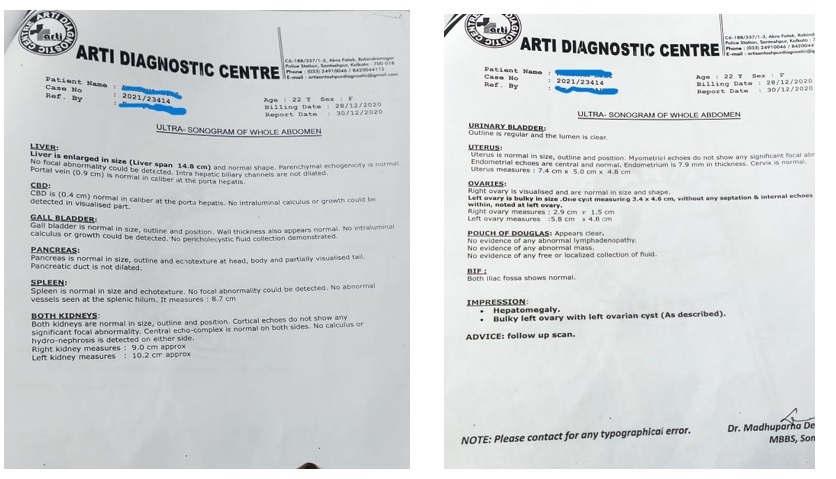
FIGURE -3. A,B (after treatment)
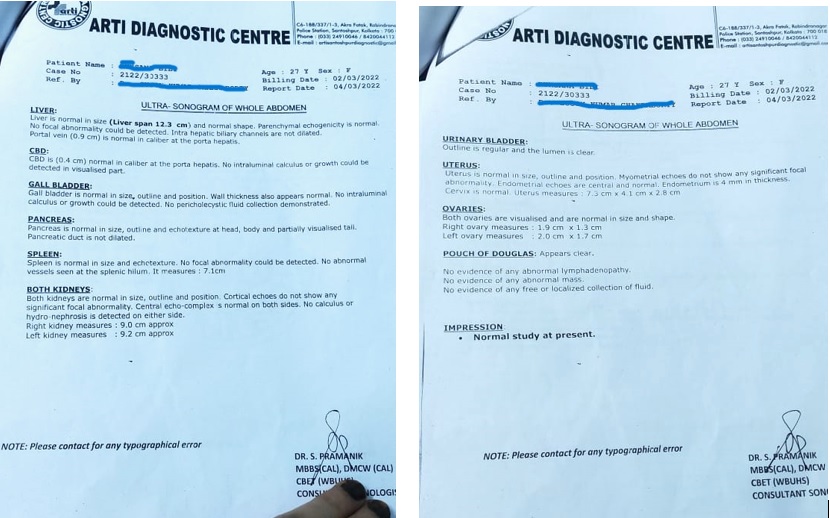
FIGURE-4. A,B (USG plates before and after treatment)
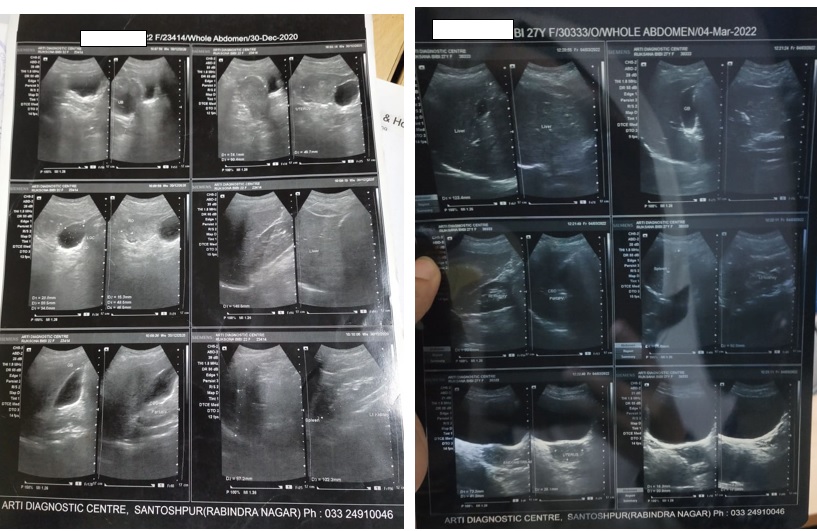
References :-
- Mobeen S, Apostol R. Ovarian cyst. [Updated 2021 June 10]. Statpearls [Internet]. [cited on 7/4/2022].
- Caryford TJB, Campbell S, Bourne TH, Rawson HJ, Collins WP. Benign ovarian cysts and ovarian cancer: A cohort study with implications for screening. Lancet 2000; 355:1060-3.
- Bailey CL, Ueland FR, Land GL, DePriest PD, Gallion HH, Kryscio RJ, et al. The malignant potential of small cystic ovarian tumours in woman over 50 years of age. Gynecol Oncol.1998; 69:3-7.
- Roman LD. Small cystic pelvic masses in older woman: Is surgical removal necessary? Gynecol Oncol.1998; 69:1-2.
- Grimes DA, Jones LB, Lopez LM, Schulz KF. Oral contraceptives for functional ovarian cysts. Cochrane Database of Systemic Reviews 2009, Issue 2. Art. No.: CD006134. DOI: 10.1002/14651858.CD006134.pub3.
- Speight P. A comparison of the chronic miasms. Health science press Publishers: London;1961.
- Shah JJ. Hompath Classic M.D Repertory. Ver. 8.0. Mumbai, India: Mind Technologies Pvt. Ltd.; 2002.
- Boericke W. Pocket Manual of Homoeopathic Materia Medica and Repertory. 51st impression. New Delhi: B. Jain Publishers (P) Ltd.; 2011. P.132-135.
- Kent JT. Lectures on Homoeopathic Philosophy. New Delhi: B. Jain Publishers (P) Ltd.; 2011. P.231-41.
- Hahnemann S. Organon of Medicine. 6th ed. New Delhi: B. Jain Publishers (P) Ltd.;2011.
- Van Haselen RA. Development of a supplement (HOM- CASE) to the CARE clinical case reporting guideline. Complement Ther Med. 2016;25:78-85.
- Gupta G, Singh N, Singh R, Singh S, Nayak C, Khurana A. Evidence based clinical study on the effect of homoeopathic medicines in cases of ovarian cyst. Indian journal of research in homoeopathy. 2011;5(1):136-42. [cited on 10/4/2022].
- Llusia M. Homoeopathic treatment of ovarian cyst- a series of 40 cases. British Homoeopathic Journal. 1991;80(3):143-148. DOI: 10.1016/S0007-0785(05)80225-X.
- Singh P. Ovarian Cyst and Homoeopathy: A Case.TU J. Homo & Medi. Sci. 2020;3(3):122-126. [cited on 10/4/2022].
- Rath P. Management of PCOS through Homoeopathy- A case report. Indian J Res Homoeopathy. 2018;12:95-100. Available at – http://www.ijrh.org DOI:10.4103/ijrh.ijrh_55_15.
- Pal P. Mahato J. Homoeopathic treatment of combined pathology of kidney and ovarian cyst with bulky uterus. World Journal of Pharmaceutical Research. 2019;8(4):897-904. DOI: 10.20959/wjpr20194-14537.
- Mishra S. Mishra R. A case of haemorrhagic cyst. TUJ. Homo & Medi. Sci. 2021;4(2):36-40.
- Deep A. A case of Haemorrhagic ovarian cyst cured with homoeopathic similimum. International Journal of Research in AYUSH and Pharmaceutical Scinces.2020;4(1):385-387.
- Kumari P. Hemorrhagic ovarian cyst treated with constitutional homoeoathy: A case report. International Journal of Homoeopathic Sciences. 2020;4(4):143-147.
- Chakma A. Sarangi MR. Homoeopathic treatment of hepatic haemangioma with ovarian cyst. Indian J Res Homoeopathy. 2019;13:244-50. DOI:10.4103/ijrh.ijrh_28_19.
About Author:
AUTHORS: – Dr Sadia Kamal1, Dr Nickey Taechen Bhutia2, Dr Torsa das3, Dr Sayantan Bhowmick4
- Dr Sadia Kamal
Post Graduate Trainee, Department of Practice of medicine, The Calcutta Homoeopathic
Medical College and Hospital
2. Dr Nickey Taechen Bhutia
Post Graduate Trainee, Department of Practice of medicine, The Calcutta Homoeopathic
Medical College and Hospital
3. Dr Torsa Das.
Post Graduate Trainee, Department of Practice of medicine, The Calcutta
Homoeopathic Medical College and Hospital.
4. Dr Sayantan Bhowmick
Post Graduate Trainee, Department of Practice of medicine, The Calcutta Homoeopathic
Medical College and Hospital



